

Arts Program Shows Promise in Special Ed. Classes - Education Week. Published Online: May 20, 2014 Published in Print: May 21, 2014, as Arts Program Shows Promise in Special Ed.
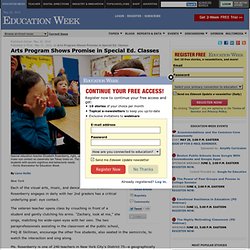
Classes Special education teacher Elizabeth Rosenberry, right, uses singing in a lesson to encourage Jesus Torres-Tiamani, left, to make eye contact as classmate Ian Tokay looks on. The strategy comes from a federally backed arts initiative for students with severe cognitive and behavioral needs —Emile Wamsteker for Education Week New York Each of the visual arts, music, and dance activities Elizabeth Rosenberry engages in daily with her 2nd graders has a critical underlying goal: eye contact. 7 Creative-Thinking Strategies: Tips for Getting... “Think outside the box.”
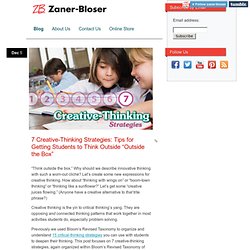
A Tool Box for Managing Stress. By Marcia Eckerd, Ph.D Kids with learning disabilities live with a great deal of stress in their lives, a result of their daily efforts to meet the demands of school, navigate the social environment, and handle all the activities on their plate.

Parents of kids with LD and ADHD have too much stress as well, juggling family, work, and the logistics of getting everyone everywhere. Parents who learn to handle stress themselves are healthier and more effective, and can teach the same skills to their children. About UDL. Principle III. Provide Multiple Means of Engagement. Click to Get the Guidelines!

5 Powerful Questions Teachers Can Ask Students. My first year teaching a literacy coach came to observe my classroom.

Anxious Students? Amping Up May Be Better Than Calming Down, Study Finds - Inside School Research. Say What? 5 Ways to Get Students to Listen. Ah, listening, the neglected literacy skill.
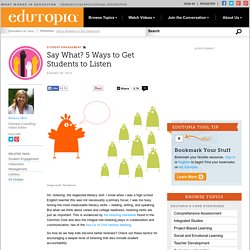
I know when I was a high school English teacher this was not necessarily a primary focus; I was too busy honing the more measurable literacy skills -- reading, writing, and speaking. But when we think about career and college readiness, listening skills are just as important. This is evidenced by the listening standards found in the Common Core and also the integral role listening plays in collaboration and communication, two of the four Cs of 21st century learning. So how do we help kids become better listeners? Check out these tactics for encouraging a deeper level of listening that also include student accountability: Strategy #1: Say it Once. Six Scaffolding Strategies to Use with Your Students. What’s the opposite of scaffolding a lesson? Saying to students, “Read this nine-page science article, write a detailed essay on the topic it explores, and turn it in by Wednesday.” Yikes! Walking the Walk: An Educator's Perspective from All Views.
As an education professor, I recently decided it was time to walk the walk of my graduate and undergraduate students.
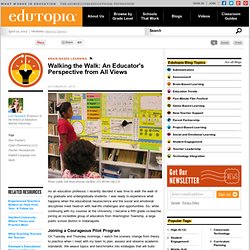
I was ready to experience what happens when the educational neuroscience and the social and emotional disciplines meet head-on with real-life challenges and opportunities. The Mind of a Middle Schooler: How Brains Learn. In my last post, I began a celebration of brains and made the argument as to why teachers need to brush up on their knowledge of brains in order to reach that all-too-allusive 'tween noggin.
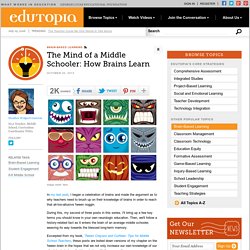
During this, my second of three posts in this series, I'll bring up a few key terms you should know in your own neurologic education. Then, we'll follow a history-related fact as it enters the brain of an average middle schooler, weaving its way towards the blessed long-term memory. Excerpted from my book, 'Tween Crayons and Curfews: Tips for Middle School Teachers, these posts are boiled down versions of my chapter on the 'tween brain in the hopes that we not only increase our own knowledge of our clientele, but share that knowledge with them as well. Brain Talk Before we proceed, here are some key words to know: Automatic Brain: This is also known as the reactive brain and makes up the remaining 83 percent of the brain.
5 Powerful Questions Teachers Can Ask Students. Strategies to Prevent the Neurotoxic Impact of School Stress. Public high school students in large U.S. cities are more likely to drop out than ever before.
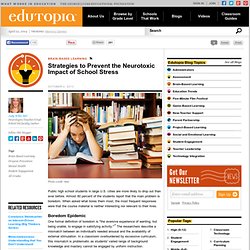
Almost 80 percent of the students report that the main problem is boredom. When asked what bores them most, the most frequent responses were that the course material is neither interesting nor relevant to their lives. Brains and Schools: A Mismatch. 'Growth Mindset' Gaining Traction as School Improvement Strategy. Published Online: September 10, 2013 Published in Print: September 11, 2013, as 'Growth Mindset' Gaining Traction As Ed.
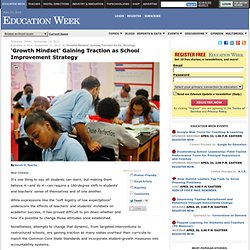
Strategy New Orleans. The 6 Secrets. Express 6.04 - 10 Essential Strategies for Teaching Boys Effectively. 8 Things That Can Make You Smarter. This article originally appeared on Annie Murphy Paul's Brilliant Blog. Eight Ways of Looking at Intelligence. Big Ideas In “Thirteen Ways of Looking At A Blackbird,” poet Wallace Stevens takes something familiar—an ordinary black bird—and by looking at it from many different perspectives, makes us think about it in new ways.
With apologies to Stevens, we’re going to take the same premise, but change the subject by considering eight ways of looking at intelligence—eight perspectives provided by the science of learning. A few words about that term: The science of learning is a relatively new discipline born of an agglomeration of fields: cognitive science, psychology, philosophy, neuroscience. Its project is to apply the methods of science to human endeavors—teaching and learning—that have for centuries been mostly treated as an art. Try This: Willpower Experiment for Making Smarter, Healthier Choices. Brain Health and Current Events. Quieter classrooms, halls within Talahi. Deeper Learning: A Collaborative Classroom Is Key. The Visual Workplace, and How to Build It. Terry Duffy At Sur-Seal, a family-owned business in Cincinnati, Mick Wilz used a Lego model to show co-workers what a redesign of the factory floor would entail. I compensated for my reading difficulty by developing superb listening skills.
If a teacher explained something, I understood it. I also had excellent spatial skills and was good at designing and fixing things. Somehow I got through school, and luckily the family business, Sur-Seal, in Cincinnati, was there for me when I graduated from high school. We design and fabricate industrial sealing solutions that include gaskets and other components. I started working in building maintenance and rose to head of operations in the 1990s. Students Are Competent to Show Us What They Need to Learn. What Neuroscience Tells Us About Deepening Learning. Teachers as Brain-Changers: Neuroscience and Learning. Optimizing Young Readers' Brains: Lessons from Neuroscience. Dyslexia Caused By Signal Processing In The Brain.
Research Traces Impacts of Childhood Adversity. Welcome. Response: Using 'Brain-Based Learning' in the Classroom - Classroom Q&A With Larry Ferlazzo. A Research-Based Approach to Arts Integration. At Bates Middle School in Annapolis, Maryland, arts integration has helped raise student achievement. Job-embedded professional development, differentiated arts instruction, and critical-thinking skills integrated into the curricula have been key to their success. Lesson Plans and Resources for Arts Integration. Dance in science, pop art in Spanish, or photography in math -- there’s no end to the ways arts can be integrated into other curricula. How the Arts Unlock the Door to Learning. Students at Bates Middle School learn about art concepts such as photo composition (above) that are integrated into other curricula like math.